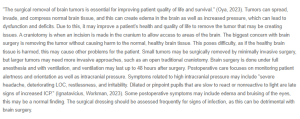Response – Surgical Management of Brain Tumors
Hello,
You have identified key attributes of brain tumor surgery and stressed the need to focus on enhancing the quality of life and survival rates. Indeed, surgery is an active component for managing brain tumors, including relieving intracranial pressure and lessening neurological impairments. In addition, knowing how craniotomy works and the possibility of endangering the sound parts of the brain is quite enlightening. Intracranial pressure has been noted by Patchana et al. (2022) to hold great importance in postoperative care, as it determines the rate of patients and recovery as well as the outcomes achieved.
Closely observing the patients for postoperative signs like severe headache, altered mental status, and abnormal pupil reaction is critical for timely diagnosis of complications. Swelling and discoloration of the skin, especially around the eyes, are relatively normal, though they should cause some concern if they begin to aggravate. It is crucial to assess the surgical dressings for infection, as infections are especially concerning following brain surgery. Moreover, the use of current innovations regarding surgical procedures, including minimally invasive surgeries for small malignant growths, brings another learning dimension to how medical enhancements enhance the patient’s well-being. Detailed treatment options of brain tumor surgery management and adjuvant modalities and the role of novel technologies point to the significance of the integrated, interdisciplinary approach in neurosurgical management (Mithany et al., 2023).
In conclusion, your discussion remains pertinent and comprehensive in outlining the vital aspects of brain tumor surgery, such as the actual surgery, its risks, postoperative measures, and the changes brought by modern innovations. Great work!
References
Mithany, R. H., Aslam, S., Abdallah, S., Abdelmaseeh, M., Gerges, F., Mohamed, M. S., Manasseh, M., Wanees, A., Shahid, M. H., Khalil, M. S., & Daniel, N. (2023). Advancements and Challenges in the Application of Artificial intelligence in the Surgical Arena: A literature review. Curēus. https://doi.org/10.7759/cureus.47924
Patchana, T., Lopez, J. A., Majeed, G., Ho, A., Alarcon, T., Plantak, N., Vu, P., & Siddiqi, J. (2022). The awake craniotomy: A patient’s experience and a literature review. Cureus, 14(6), e26441. https://doi.org/10.7759/cureus.26441
ORDER A PLAGIARISM-FREE PAPER HERE
We’ll write everything from scratch
Question 
Discuss: surgical management of brain tumors

Response – Surgical Management of Brain Tumors
“The surgical removal of brain tumors is essential for improving patient quality of life and survival.” (Oya, 2023). Tumors can spread, invade, and compress normal brain tissue, and this can create edema in the brain as well as increased pressure, which can lead to dysfunction and deficits. Due to this, it may improve a patient’s health and quality of life to remove the tumor that may be creating issues. A craniotomy is when an incision is made in the cranium to allow access to areas of the brain. The biggest concern with brain surgery is removing the tumor without causing harm to the normal, healthy brain tissue. This poses difficulty, as if the healthy brain tissue is harmed, this may cause other problems for the patient. Small tumors may be surgically removed by minimally invasive surgery, but larger tumors may need more invasive approaches, such as an open traditional craniotomy. Brain surgery is done under full anesthesia and with ventilation, and ventilation may last up to 48 hours after surgery. Postoperative care focuses on monitoring patient alertness and orientation as well as intracranial pressure. Symptoms related to high intracranial pressure may include “severe headache, deteriorating LOC, restlessness, and irritability. Dilated or pinpoint pupils that are slow to react or nonreactive to light are late signs of increased ICP.” (Ignatavicius, Workman, 2023). Some postoperative symptoms may include edema and bruising of the eyes, this may be a normal finding. The surgical dressing should be assessed frequently for signs of infection, as this can be detrimental with brain surgery.
Resources
Ignatavicius. D. D… Workman, M. L., Rebar, C. R., & Heimgartner, N. M. (2021). Medical-Surgical Nursing: Concepts for Interprofessional Collaborative Care. Elsevier.
Oya. S. (2023, September 14). Recent advancements in the surgical treatment of brain tumors. Current oncology (Toronto, Ont.). https://www.ncbi.nlm.nih.gov/pmc/articles/PMC10527654/